英汉互译在线翻译句子教案资料
- 格式:doc
- 大小:48.00 KB
- 文档页数:10
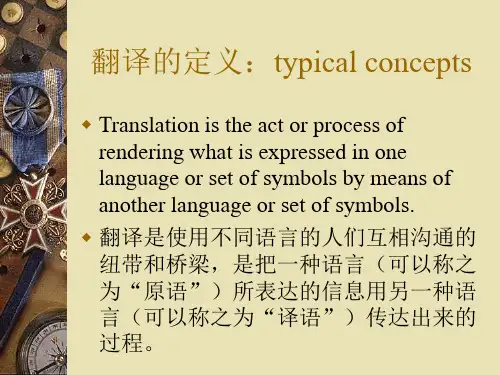
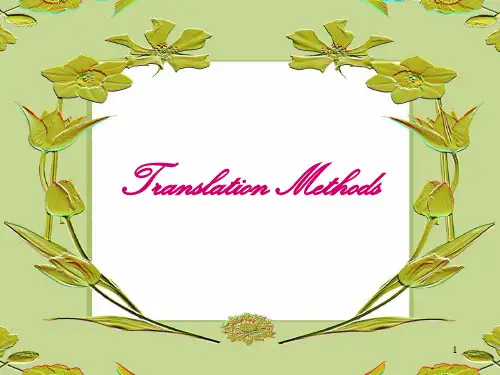
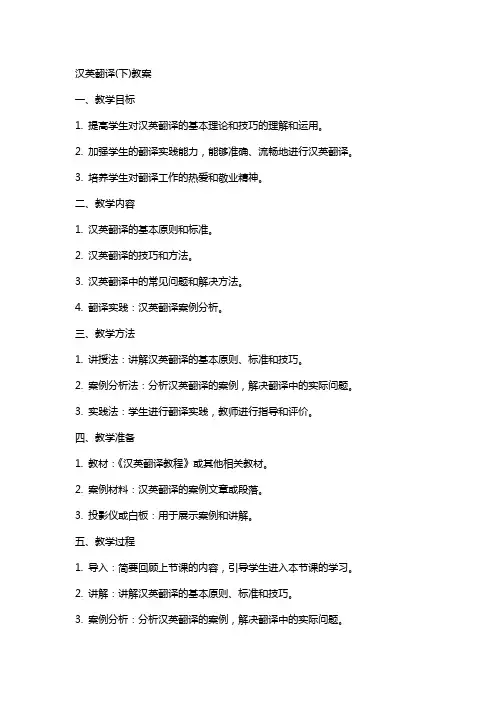
汉英翻译(下)教案一、教学目标1. 提高学生对汉英翻译的基本理论和技巧的理解和运用。
2. 加强学生的翻译实践能力,能够准确、流畅地进行汉英翻译。
3. 培养学生对翻译工作的热爱和敬业精神。
二、教学内容1. 汉英翻译的基本原则和标准。
2. 汉英翻译的技巧和方法。
3. 汉英翻译中的常见问题和解决方法。
4. 翻译实践:汉英翻译案例分析。
三、教学方法1. 讲授法:讲解汉英翻译的基本原则、标准和技巧。
2. 案例分析法:分析汉英翻译的案例,解决翻译中的实际问题。
3. 实践法:学生进行翻译实践,教师进行指导和评价。
四、教学准备1. 教材:《汉英翻译教程》或其他相关教材。
2. 案例材料:汉英翻译的案例文章或段落。
3. 投影仪或白板:用于展示案例和讲解。
五、教学过程1. 导入:简要回顾上节课的内容,引导学生进入本节课的学习。
2. 讲解:讲解汉英翻译的基本原则、标准和技巧。
3. 案例分析:分析汉英翻译的案例,解决翻译中的实际问题。
4. 翻译实践:学生进行翻译实践,教师进行指导和评价。
六、教学评估1. 平时作业:布置汉英翻译的练习题,要求学生按时完成并提交。
2. 课堂表现:观察学生在课堂上的参与程度、提问回答和翻译实践的表现。
3. 期末考试:设置汉英翻译的考试题目,评估学生的翻译水平和掌握程度。
七、教学拓展1. 组织翻译讲座:邀请专业的翻译人员或翻译学者进行讲座,分享翻译经验和技巧。
2. 开展翻译小组活动:学生分组进行翻译实践,互相讨论和交流,提高翻译能力。
3. 推荐翻译相关书籍:向学生推荐一些汉英翻译的经典书籍,鼓励学生自主学习和研究。
八、教学反馈1. 学生反馈:收集学生对教学内容和方法的反馈意见,了解学生的需求和改进建议。
九、教学资源1. 网络资源:利用网络资源,提供更多的汉英翻译案例和资料,供学生自主学习和参考。
2. 翻译软件:介绍一些翻译软件和工具的使用方法,帮助学生提高翻译效率和准确性。
3. 参考书籍:向学生推荐一些汉英翻译的参考书籍,供学生深入学习和发展。
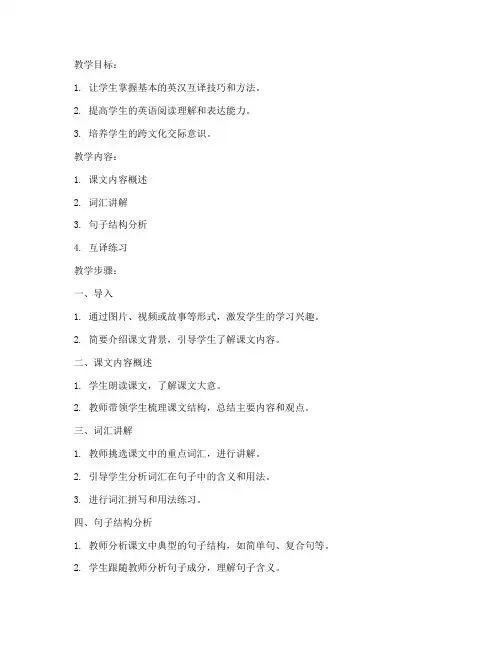
教学目标:1. 让学生掌握基本的英汉互译技巧和方法。
2. 提高学生的英语阅读理解和表达能力。
3. 培养学生的跨文化交际意识。
教学内容:1. 课文内容概述2. 词汇讲解3. 句子结构分析4. 互译练习教学步骤:一、导入1. 通过图片、视频或故事等形式,激发学生的学习兴趣。
2. 简要介绍课文背景,引导学生了解课文内容。
二、课文内容概述1. 学生朗读课文,了解课文大意。
2. 教师带领学生梳理课文结构,总结主要内容和观点。
三、词汇讲解1. 教师挑选课文中的重点词汇,进行讲解。
2. 引导学生分析词汇在句子中的含义和用法。
3. 进行词汇拼写和用法练习。
四、句子结构分析1. 教师分析课文中典型的句子结构,如简单句、复合句等。
2. 学生跟随教师分析句子成分,理解句子含义。
3. 学生进行句子翻译练习。
五、互译练习1. 教师给出一段英文,学生将其翻译成汉语。
2. 学生相互检查翻译,教师点评并纠正错误。
3. 教师给出一段汉语,学生将其翻译成英语。
4. 学生相互检查翻译,教师点评并纠正错误。
六、课堂小结1. 教师总结本节课所学内容,强调重点和难点。
2. 学生回顾课文内容,巩固所学知识。
七、课后作业1. 学生完成课后练习题,巩固所学词汇和句型。
2. 学生尝试将课文中的段落翻译成英语或汉语。
教学反思:1. 教师应关注学生的学习效果,及时调整教学方法。
2. 注重培养学生的自主学习能力,鼓励学生积极参与课堂活动。
3. 在教学过程中,关注学生的个体差异,因材施教。
4. 通过实践活动,提高学生的实际运用能力。
教学时间:1课时教学资源:1. 课文原文2. 词汇卡片3. 句型练习册4. 翻译练习题5. 课件或黑板教学评价:1. 课堂参与度:观察学生在课堂上的发言、提问和练习情况。
2. 翻译准确性:检查学生的翻译练习,评估其翻译水平。
3. 课后作业完成情况:检查学生的课后作业,了解其对所学知识的掌握程度。
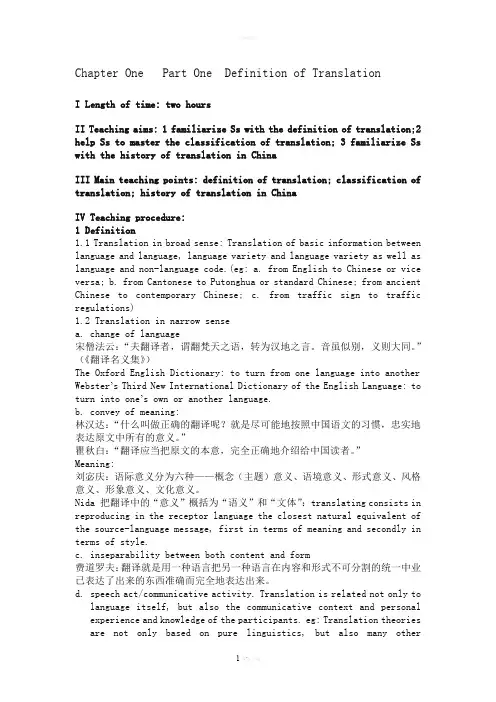
Chapter One Part One Definition of TranslationI Length of time: two hoursII Teaching aims: 1 familiarize Ss with the definition of translation;2 help Ss to master the classification of translation; 3 familiarize Ss with the history of translation in ChinaIII Main teaching points: definition of translation; classification of translation; history of translation in ChinaIV Teaching procedure:1 Definition1.1 Translation in broad sense: Translation of basic information between language and language, language variety and language variety as well as language and non-language code.(eg: a. from English to Chinese or vice versa; b. from Cantonese to Putonghua or standard Chinese; from ancient Chinese to contemporary Chinese; c. from traffic sign to traffic regulations)1.2 Translation in narrow sensea.change of language宋僧法云:“夫翻译者,谓翻梵天之语,转为汉地之言。
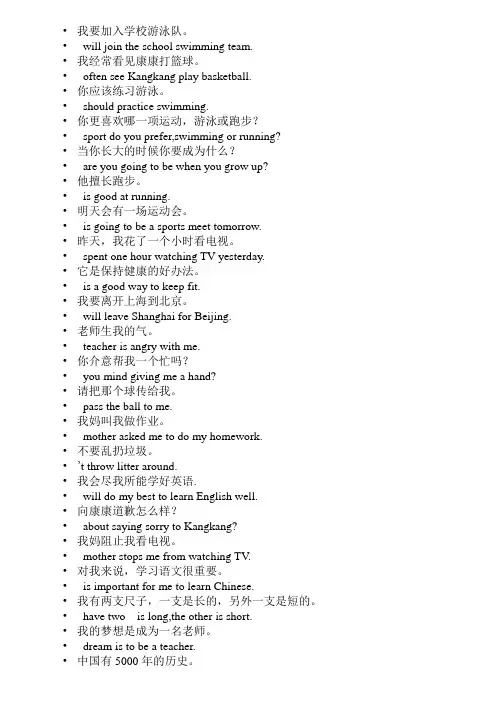
•我要加入学校游泳队。
•will join the school swimming team.•我经常看见康康打篮球。
•often see Kangkang play basketball.•你应该练习游泳。
•should practice swimming.•你更喜欢哪一项运动,游泳或跑步?•sport do you prefer,swimming or running?•当你长大的时候你要成为什么?•are you going to be when you grow up?•他擅长跑步。
•is good at running.•明天会有一场运动会。
•is going to be a sports meet tomorrow.•昨天,我花了一个小时看电视。
•spent one hour watching TV yesterday.•它是保持健康的好办法。
•is a good way to keep fit.•我要离开上海到北京。
•will leave Shanghai for Beijing.•老师生我的气。
•teacher is angry with me.•你介意帮我一个忙吗?•you mind giving me a hand?•请把那个球传给我。
•pass the ball to me.•我妈叫我做作业。
•mother asked me to do my homework.•不要乱扔垃圾。
•’t throw litter around.•我会尽我所能学好英语.•will do my best to learn English well.•向康康道歉怎么样?•about saying sorry to Kangkang?•我妈阻止我看电视。
•mother stops me from watching TV.•对我来说,学习语文很重要。
•is important for me to learn Chinese.•我有两支尺子,一支是长的,另外一支是短的。
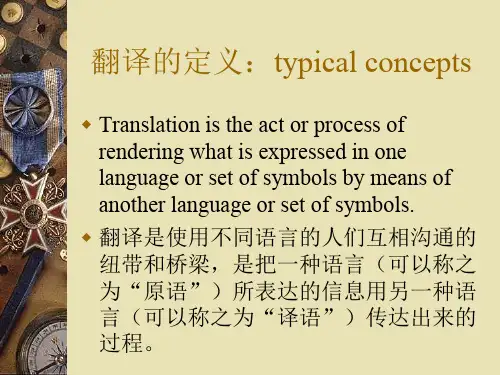
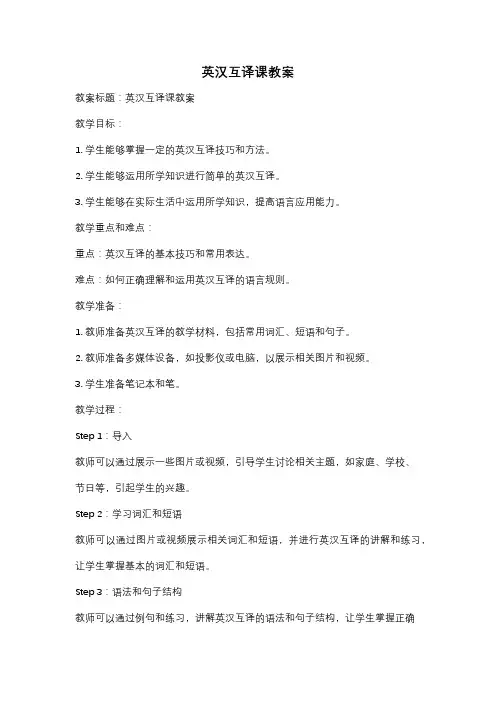
英汉互译课教案
教案标题:英汉互译课教案
教学目标:
1. 学生能够掌握一定的英汉互译技巧和方法。
2. 学生能够运用所学知识进行简单的英汉互译。
3. 学生能够在实际生活中运用所学知识,提高语言应用能力。
教学重点和难点:
重点:英汉互译的基本技巧和常用表达。
难点:如何正确理解和运用英汉互译的语言规则。
教学准备:
1. 教师准备英汉互译的教学材料,包括常用词汇、短语和句子。
2. 教师准备多媒体设备,如投影仪或电脑,以展示相关图片和视频。
3. 学生准备笔记本和笔。
教学过程:
Step 1:导入
教师可以通过展示一些图片或视频,引导学生讨论相关主题,如家庭、学校、
节日等,引起学生的兴趣。
Step 2:学习词汇和短语
教师可以通过图片或视频展示相关词汇和短语,并进行英汉互译的讲解和练习,让学生掌握基本的词汇和短语。
Step 3:语法和句子结构
教师可以通过例句和练习,讲解英汉互译的语法和句子结构,让学生掌握正确
的表达方式。
Step 4:综合练习
教师可以设计一些综合练习,让学生运用所学知识进行英汉互译,加深对知识
的理解和应用能力。
Step 5:作业布置
教师可以布置相关的作业,让学生在课后进行巩固练习,提高学生的学习效果。
教学反思:
教师可以通过课后总结和学生的表现,对教学过程进行反思和总结,不断完善
教学方法和内容,提高教学质量。
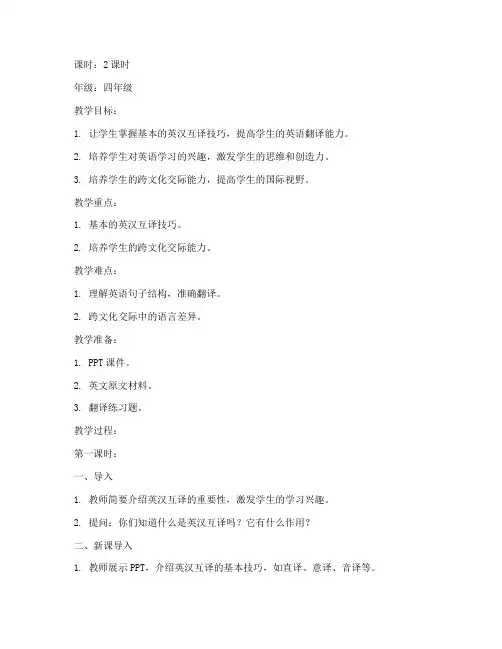
课时:2课时年级:四年级教学目标:1. 让学生掌握基本的英汉互译技巧,提高学生的英语翻译能力。
2. 培养学生对英语学习的兴趣,激发学生的思维和创造力。
3. 培养学生的跨文化交际能力,提高学生的国际视野。
教学重点:1. 基本的英汉互译技巧。
2. 培养学生的跨文化交际能力。
教学难点:1. 理解英语句子结构,准确翻译。
2. 跨文化交际中的语言差异。
教学准备:1. PPT课件。
2. 英文原文材料。
3. 翻译练习题。
教学过程:第一课时:一、导入1. 教师简要介绍英汉互译的重要性,激发学生的学习兴趣。
2. 提问:你们知道什么是英汉互译吗?它有什么作用?二、新课导入1. 教师展示PPT,介绍英汉互译的基本技巧,如直译、意译、音译等。
2. 教师举例说明,让学生理解各种翻译技巧的运用。
三、课堂练习1. 教师提供一段英文原文,让学生进行翻译练习。
2. 教师点评学生的翻译,指出优点和不足,帮助学生改进。
四、课堂小结1. 教师总结本节课所学内容,强调英汉互译的基本技巧。
2. 鼓励学生在日常生活中多进行英汉互译练习,提高自己的翻译能力。
第二课时:一、复习导入1. 教师提问:上节课我们学习了什么内容?你们还记得吗?2. 学生回答,教师点评。
二、新课导入1. 教师展示PPT,介绍跨文化交际中的语言差异。
2. 教师举例说明,让学生了解不同文化背景下的语言差异。
三、课堂练习1. 教师提供一段英文原文,要求学生在翻译时注意跨文化交际。
2. 教师点评学生的翻译,指出优点和不足,帮助学生改进。
四、课堂小结1. 教师总结本节课所学内容,强调跨文化交际中的语言差异。
2. 鼓励学生在日常生活中多进行跨文化交际练习,提高自己的交际能力。
教学评价:1. 学生能够掌握基本的英汉互译技巧。
2. 学生能够理解并运用跨文化交际中的语言差异。
3. 学生能够积极参与课堂练习,提高自己的翻译和交际能力。
教学反思:1. 教师应关注学生的个体差异,针对不同学生的需求进行教学。
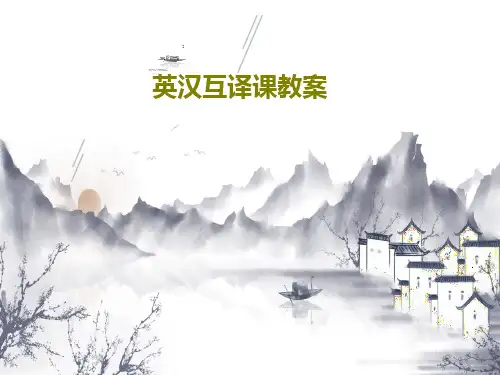
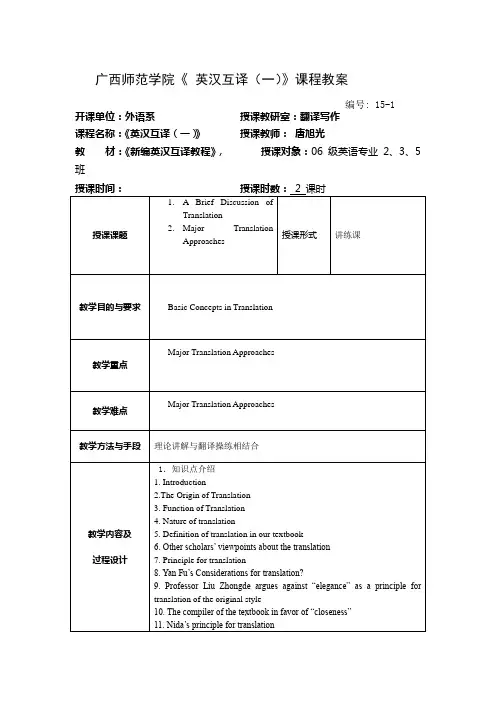
广西师范学院《英汉互译(一)》课程教案编号: 15-1 开课单位:外语系授课教研室:翻译写作课程名称:《英汉互译(一)》授课教师:唐旭光教材:《新编英汉互译教程》,授课对象:06级英语专业2、3、5班《英汉互译(一)》第一讲翻译简论与主要翻译方法(A Brief Discussion of Translation and Major Translation Approaches)1. IntroductionTranslation studies started along with translation practice. Translation theories developed flourishingly in the 20th century, especially in the second half of the last century.In fact, translation, which is a very complex phenomenon, is related to different disciplines, such as linguistics, psychology, sociology, cultural anthropology, communication theory, literary criticism, aesthetics, and semiotics. As translation study is a cross-discipline and cross-culture subject involving many aspects of human knowledge, the lack of a fully acceptable theory of translation should not come as a surprise. Meanwhile, quite a number of translation approaches and strategies have become universally acceptable and widely applicable. They are, of course, the fruits of many translation theorists and translation practitioners at home and abroad.2.The Origin of TranslationLanguage makes it possible for people to communicate with one another freely so as to complete important tasks in human life. Translation makes it possible for people from different languages to communicate with one another so as to complete important tasks in their life.Theodore Savory points out, “Translation is almost as old as original authorship and has a history as honorable and as complex as that of any other branch of literature”(申雨平, 2002:4).In Zhou Dynasty there were different forms of address for translators in different places. “Translators are called Ji in the east, Xiang in the south, Didi in the west, andYi in the north(东方曰寄,南方曰象,西方曰狄鞮,北方曰译)”(陈福康, 2000:3).3. Function of TranslationIt has helped people to better communicate with one another, and in the mean time it has facilitated the development of culture and civilization of all nations, such as the Sutra translation (佛经翻译)in China and the Bible translation in Western countries.Actually, translation, as a means to bridge different cultures, has been playing a very important role in promoting global economic and cultural development, and China in particular benefits a great deal from translation, which is obvious to all.4. Nature of translationOne school of theorists maintain that any interpretation is translation. Translation thus defined includes intra-lingual rewording(语言内的重新措辞), inter-lingual (语言之间的翻译或语际翻译)translation and inter-semiotic transmutation(符号转换).But most scholars who are interested in translation maintain that translation is a communicative activity which entails a most adequate or identical reproduction in a target language of a written message or text in a source language.5. Definition of translation in our textbook as follows: Translation or translating is a communicative activity or dynamic process in which the translator makes great effort to thoroughly comprehend a written message or text in the source language and works very hard to achieve an adequate or an almost identical reproduction in the target language version of the written source language message or text. In terms of its nature or character, translation is both an art and a science as well, since it calls for a good command of at least two languages, a flexible application of their rules, and some knowledge of at least two cultures, as well as a good grasp of the necessary translation theories.6. Other scholars’ viewpoints about the translation1). The traditional viewpoint about the nature of translation is that translation is an art only. This viewpoint is still maintained by Xu Yuanchong(许渊冲), a well-known professor at Beijing University, and a few other scholars.2). Professor Liu Zhongde vigorously advocates that translation is a science as well as an art mainly because of the following reasons:Firstly, like any other art and science, translation requires a good grasp and a flexible use of the necessary specialized knowledge and skills.Secondly, like any other art and science, translation calls for independent, honest and creative effort.Thirdly, just like any other art and science, translation demands that the translator be very careful about and highly responsible for his or her work.7. Principle for translationThe 13 statements on page 81). A translation must reproduce the words of the SLT(Source Language Text).2). A translation must reproduce the ideas (meaning) of the SLT.3). A translation should read like an original work.4). A translation should read like a translation.5). A translation should reflect the style of the original.6). A translation should possess the style of the translator.7). A translation should retain the historical stylistic dimension of the SLT.8). A translation should read as a contemporary piece of literature.9). A translation may add to or omit from the original.10). A translation may never add to or omit from the original.11). A translation should let the readers of the SLT and the target language text (TLT) have essentially the same response.12). A translation should convey what the SLT author intends to convey.13). A translation should satisfy the need of the client.Evidently, though each of the above statements is right in a certain sense, yet it is not adequate or comprehensive enough to serve as a translation principle. Some of the principles proposed by various translation theorists can find their expression in the statements given above. Interlinear translation is an illustration of the first statement. Yan Fu’s three-character principle can be a combination of statements 2, 3 and 6. Nida’s functional equivalence is best express ed in statement 11.8. Yan Fu’s Considerations for translation?Strictly speaking, a translation theory in its true sense in China originated from Yan Fu(严复). He proposed the famous triple principle for translation, namely, faithfulness(信), expressiveness(达) and elegance(雅).1). His faithfulness means that the translated text should be faithful to the original text, ie, the version should keep the content or ideas of the original.2). His expressiveness means that the translated text should be expressive and coherent without anything awkward. In other words, his expressiveness requires that the version should be fluid, smooth, and easy to read and understand.3). His elegance demands that the translated text should be exquisite and that its style ought to be very graceful.9. Professor Liu Zhongde argues against “elegance” as a principle for translation of the original styleHe argued eloquently against “elegance” as a principle for translation of the original style. We all know that not all works are characterized by the elegant style. Different writers display different styles. For instance, Lenin wrote in a bold style, and Hemingway wrote in a simple, symbolic style. Even the same writer shows different styles on different occasions for different purposes. Naturally, different works demonstrate different styles. Thus, it is impossible & absolutely wrong to achieve the effect of elegance in the translated text if the style of the original is not elegant.10. The compiler of the textbook in favor of “closeness”1). We are in favor of Professor Liu’s triple translation principle. He changed Yan Fu’s “elegance” into “closeness”, which represents his contribution to the translation theory. His “closeness” is central in meaning. It is suitable for translation of all types of texts with different styles.2). If the original text is characterized by the elegant style, the translator should do his utmost to render it into a graceful text in the target language whose style is close to the original elegant style.If the original style is highly technical with a wealth of technical terms, thetranslator ought to employ plenty of corresponding technical terms in the target language and make the translated style as close to the original technical style as possible.3). If the original style is colloquial with a lot of informal words and colloquial sentences, the translator should translate it into a text with an informal style as close as possible to the original one by using many colloquial words and informal sentences.If the original style is ornate, the translator should follow suit and make effort to render the translated style as close to the original as possible.If the original text contains some vulgar words and sentences, the translator is not entitled to replace them with elegant words or sentences, and he should reproduce the original by using some corresponding vulgar words and sentences in the receptor language. Translators are duty-bound to do so, for the simple reason that they are translators.4). As we know, Yan Fu’s triple translation principle is highly concise and well rhymed and quite easy to learn by heart, which is one of the reasons why it is still very popular in China today.Professor Liu’s triple principle is similar to Yan Fu’s in that it is equally concise and easy to remember.Though Professor Liu’s triple principle is n ot rhymed, yet it is very forceful and impressive, for the Chinese character “切” is uttered in the falling tone, carrying the implication that faithfully conveying the original style or rendering the translated style as close to the original as possible is absolutely necessary and worth the translator’s great effort.11. Nida’s principle for translationEugene A. Nida and Taber stated emphatically (1969:12): “Translation consists in reproducing in the receptor language the closest natural equivalence of the source language message, first in terms of meaning and secondly in terms of style”.His dynamic equivalence is defined as a translation principle, according to which the translator seeks to translate the meaning of the original in such a way that the target language text wording will produce the same impact on the target text audience as the original wording does upon the source text audience. Later on, Nida changed “dynamic equivalence” into “functional equivalence”, because it seemed much more satisfactory to use the expression “functional equivalence” in describing the degree of adequacy of a translation.12. The literal translation approachProfessor Liu Zhongde (1994: 172) defines literal translation as follows: “In the process of translation, literal translation treats sentences as basic units and at the same time takes the whole passage into consideration; a translator who attaches great importance to literal translation does his or her best to reproduce the ideas and writing style of the original work, retaining in the version as many rhetorical devices and sentence structures of the original as possible.”ExamplesHe is said to be a rough diamond.人们说他是一块浑金璞玉。
【教学目标】1. 知识目标:掌握汉英互译的基本技巧和常用词汇,提高学生的翻译能力。
2. 能力目标:培养学生的语言运用能力和跨文化交际能力。
3. 情感目标:激发学生对英语学习的兴趣,增强他们的自信心。
【教学重点】1. 汉英互译的基本技巧。
2. 常用词汇的翻译。
【教学难点】1. 词汇选择和表达方式的准确性。
2. 文化差异的处理。
【教学准备】1. 教学课件或黑板。
2. 汉英互译练习材料。
3. 英文原版教材或辅助教材。
【教学过程】一、导入1. 通过简短的英语对话或小故事,引入汉英互译的话题。
2. 提问学生:“What do you think is the most challenging part of translating from Chinese to English?”(你认为从中文翻译成英文最具有挑战性的是什么?)二、基本技巧讲解1. 词汇选择:讲解如何根据上下文选择合适的词汇,强调词汇的准确性和地道性。
2. 句子结构:讲解中文句子和英文句子的结构差异,如主谓宾结构、定语后置等。
3. 文化差异:讲解汉英翻译中需要注意的文化差异,如习惯用法、表达方式等。
三、实例分析1. 展示一些典型的汉英互译实例,引导学生分析翻译的技巧和注意事项。
2. 学生分组讨论,分析实例中的翻译方法,并分享自己的看法。
四、实践练习1. 分发汉英互译练习材料,让学生进行练习。
2. 教师巡视指导,纠正学生的错误,并给予个别辅导。
五、课堂展示1. 邀请部分学生展示自己的翻译作品,并给予评价和反馈。
2. 学生互相评价,分享翻译心得。
六、总结与反思1. 教师总结本节课的学习内容,强调汉英互译的技巧和注意事项。
2. 学生反思自己的学习过程,提出改进意见。
【课后作业】1. 完成课后练习题,巩固所学知识。
2. 额外阅读相关材料,扩大词汇量。
【教学反思】1. 教师反思教学效果,针对学生的实际需求调整教学策略。
2. 学生反思自己的学习效果,找出自己的不足,制定改进计划。
《英汉翻译》课程教案•课程编号: •周课时: •总课时: •学分: •考试方式: •教材: •参考书: BZB032232342分考查新编英汉翻译教程孙致礼编英汉翻译教程张培基编实用翻译教程冯庆华编ContentsChapter 1 What Is Translation (1)Chapter 2 The Process of Translation (15)Chapter 3 The linguistic Approach toTranslation (25)Chapter 4 Conversion (35)Chapter 5 The importance of diction (43)Chapter 6 Translation concerning negation (48)Chapter 7 Ampliflcation (53)Chapter 8 Repetition (58)Chapter 9 Changes of sentence parts (62)Chapter 10 Translation of attributive clause (66)Chapter 11 Translation of Long Sentences (69)Chapter 12外位语结构在英译汉中的应用 (73)Chapter 13 Translation of Passive Voice (77)Chapter 14 Translation of figures of speech (83)Chapter 15 Translation of idioms (87)Chapter 1 What Is TranslationAims: To understand the basic principles of translation and translation studiesKey points: the nature of translation, definition of translationDifficulties: the nature of translation, history of translationTeaching procedures1.The nature of translation•Translation is of great importance in learning a foreign language. Many of those who learn English will be English Chinese translators in the future. There are many translation theories and techniques for you too learn .•Without knowing the theories and the techniques one will most likely take a roundabout course in translation work. That's why it is necessary for you to have a good command of both the source language and the target language, and of the theories and the techniques in translation.•What is translation?Translation is a representation or recreation in one language of what is written or said in another language.or : Translation is an activity of reproducing in one language the ideas which have been expressed in another language.(翻译是把一种语言所表达的思想用另一种语言重新表达出來的活动)•Eugene Nida, famous American translation theorist, defined translation as: Translation consists in reproducing in the receptor language the closest natural equivalent of the source-language messages, first in terms of meaning and secondly in terms of style.•翻译就是接受语言复制出与原语信息最接近的自然等值体…首先是就意义而言,其次是就其风格而言.Eugene Nida^s photo •In addition to the definitions mentioned above, various definitionshave been given to translation. Now Fd like to cite some of them:•Translation is a science ••Translation is an art.•Translation is a craft.•Translation is a skill.•Translation is an operation .•Translation is a language activity .•Translation is a communication.•Among these definitions the first two are most important for they represent two schools ■一the school of science and the school of art. The former maintains that translating should reproduce the message of the original by means of the transformation of linguistic equivalence. It puts stress on the study of description of the process of translation, and the structures and the forms of the language so as to reveal the objective laws inherent in translation. The latter advocates recreating a literary work by using expressions of another language • It emphasizes on the effect of translation.1) Translation is a science•We say translation is a science, because it has its own laws and methods. Take the translation between English and Chinese for example, if we want to translate well, we must be entirely familiar with the content of the original and all the knowledge it concerns. In addition we should have a comparatively comprehensive and thorough study of English and Chinese so that we may do our work with high proficiency.•English and Chinese are two entirely different languages. Each has an individual and distinct system. On the other hand, there are lots of differences between them both in morphology and in syntax. Because of this , we have to know both languages well, especially with the wide difference in vocabulary , grammatical relations,and sentence structure .•Now we may well conclude that translation is indeed a science with its peculiar laws and methods,a science related to lexicology .grammar, rhetoric and other branches of linguistics.2) Translation is an arte Lin Yutang was once a representative. In his essay On Translation he declares that translation is an art whose success depends on one^s artistic talent and enough training.Besides these, there no set rules for translation and there is no short cut for art.•From the examples mentioned above we can see that translation is an art, a brilliant art. Like painting, enables us to reproduce the fine thought of somebody, not in colors, but in words, in the words of a different language< It demands a broad and profound knowledge. •In other words , a translator should have an understanding of literature and art, rhetoric and aesthetics; otherwise, he can hardly accomplish the task of reproduction of the original.•In accordance with what we have discussed in the above, now we can come to the following conclusion:•Translation depends on the artistic level and the technique of the translato匸Whoever has a good command of translation both in theory and technique can offer satisfactory translations Jt is because ,as pointed out in this lecture , translation is not only a science with its own laws and methods but also an art of reproduction and recreation.2.Aim of foreign language learning and the importance of translation(1) What is the objects of a foreign language? Learning a foreign language is not easy but it is worthwhile. It enables you to read foreign scientific and technical literature, and that might be useful. It makes you enable to read some of the worlds best writers in their own language, and this is a great pleasure. But the most important thing is that it gives you a better understanding of your own language.(2) Translation is of great value to foreign language learners. It is very important to the development of our nation • Translation keeps you informed of the international situation ; translation enhances our competitive power in the international market ; translation serves as instrument of propagating traditional culture . Translation is for inter-lingual communication, bridges the gulf between different-tongue speakers,and reproduces and spreads the message in the original language. Translation permits knowledge to be transmitted to different corners of the world and to succeeding generations.•Translation gives information, reveals feelings, and affect people's thought or behavio匚Through translation, we can draw on the advanced experience and achievement in the fieldof science and technology of foreign countries. Without translation, the worldwide civilization would not be possible.•Today, translation plays an increasingly important role in our country's economic reform and opening to the world • More and more people of financial and business circles from all parts of the world come to our country and take part in joint ventures, cooperative enterprises, sole foreign-invested enterprises, and various other economic, trade and technological cooperation. This situation results in the great need of translators, English Chinese translators in particular. Translation promotes mutual understanding between Chinese and foreigners, contributes to the speeding up of our country's modernization and thus is absolutely necessary in the development of our market economy.3.Prerequisites for a translator•(1) In order to achieve genuine competence in translation, a translator must bear in mind that translation means honest, solid knowledge, and that genuine knowledge comes from practice. As translation is work that involves at least two languages ■一the first language and the second language . Therefore, to know both language fairly well is one of the prerequisites for translation.•e.g. You are telling me • (slang: I know that very well /1 knew that long ago-) 我早矢口道了. /还用你告诉我!工你正在告诉我.e.g. Now you are talking . (informal: at last you are saying something agreeable.)你到底说了合我意的话了/你这样说才合我的意思.定现在你正在谈话.•e.g. Henry Kissinger has slept there before, in July and again in Octobe匚这之前亨利基辛格在7月和1 0月两度在这里下榻.(不译为:睡觉)•陈先生乃中国学界泰斗.•Me Chen, our respected teacher , is a renowned master in the academic circles of China. •e.g.你要有所收获,则必须在学习中不断深入.•If you want to gain anything,you must constantly deepen your studies.•(2) Besides a good knowledge of both the SL and the TL, a translator should do a lot of reading, listening, and speaking. He has to experience the many ways in which the English is spoken and written by native speakers. And to be constantly exposed to English spoken and written by native speakers is considered to be a very important part of practice .without which a Chinese learner of English can't expect to acquire competence in understanding and production as far as the English language is concerned・•(3) Furthermore, acquaintance with the subject matter covered in the book or article is also an indispensable factor in doing translation work well. For instance : If you are going to translate some technological data on remote sensing of the earth by man-made satellites, you have to learn to acquire some basic knowledge of the relevant aspect of space science and technology , otherwise , you will run the risk of making mistakes in the subject matter imperceptibly. So you should have a wide background knowledge ••E.g. The Security Counci l has been seized of the question since then.安理会自那以來就一直受理这个问题。
英汉翻译教案范文教案:英汉翻译教学目标:1.学生能够准确理解英汉翻译的基本原理和方法。
2.学生能够使用正确的翻译技巧将英文翻译成中文。
3.学生能够运用所学知识,独立完成一篇简单的英汉翻译。
教学重点:1.英汉翻译的基本原理和方法。
2.翻译技巧的运用。
教学难点:1.如何有效运用翻译技巧。
2.如何把握好英汉翻译的语言风格。
教学过程:一、导入(10分钟)1.教师与学生互动,询问学生对英汉翻译的理解。
2.呈现一段英文短文,让学生尝试翻译成中文。
3.学生尝试用翻译软件进行翻译,比较不同翻译结果的准确性和流畅度。
二、基本原理介绍(20分钟)1.教师介绍英汉翻译的基本原理,如准确传递信息、保持语言风格等。
2.教师详细解释基本原理,比如意译和直译的区别、上下文的重要性等。
3.学生通过教师提供的例子,理解原理的应用。
三、翻译技巧讲解(30分钟)1.教师介绍几种翻译技巧,如同义替换、增添补充信息等。
2.教师详细解释各种翻译技巧的使用方法和注意事项。
3.学生通过练习题,运用所学翻译技巧进行翻译。
四、实际操作(30分钟)1.学生分组,每组选择一段英文短文进行翻译。
2.学生在小组内协作,运用所学翻译技巧完成翻译任务。
3.学生将翻译结果展示给全班,并互相评价。
五、总结与反思(10分钟)1.教师总结本节课所学的内容,强化学生对英汉翻译的理解。
2.学生反思自己在翻译过程中遇到的问题和不足。
3.教师给予学生反馈和建议,鼓励学生继续努力提高翻译水平。
教学资源:1.英文短文2.翻译软件3.练习题教学评估:1.学生在小组协作中的表现。
2.学生翻译的准确性和流畅度。
3.学生对翻译技巧的理解和运用。
教学延伸:1.学生可以进一步学习翻译的高级技巧和技巧,如词汇选择、语法转换等。
2.学生可以自主扩展翻译技能,进行更复杂的翻译任务。
教学反思:1.教学目标和重点难点的设置是否合理。
2.教学过程是否能够激发学生的学习兴趣和主动性。
3.教学资源的充分利用和教学评估的准确性。
英汉互译在线翻译句子 美句集锦 如果只是遇见,不能停留,不如不遇见。 if we can only encounter each other rather than stay with each other,then i wish we had never encountered.
2。宁愿笑着流泪,也不哭着说后悔。心碎了,还需再补吗? i would like weeping with the smile rather than repenting with the cry, when my heart is broken, is it needed to fix?
3。没有谁对不起谁,只有谁不懂得珍惜谁。 no one indebted for others, while many people dont know how to cherish others.
4。命里有时钟需有 命里无时莫强求 you will have it if it belongs to you, whereas you dont kvetch for it if it doesnt appear in your life.
5。当香烟爱上火柴时,就注定受到伤害 when a cigarette falls in love with a match, it is destined to be hurt.
6。爱情…在指缝间承诺 指缝…。在爱情下交缠。 love ,promised between the fingers finger rift, twisted in the love
7。没有人值得你 流泪,值得让你这么做的人不会让你哭泣。 no man or woman is worth your tears, and the one who is, won?t make you cry.
8。记住该记住的,忘记该忘记的。改变能改变的,接受不能改变的。 remember what should be remembered, and forget what should be forgotten. alter what is changeable, and accept what is unchangeable. love is like a butterfly. it goes where it pleases and it
pleases where it goes. 爱情就像一只蝴蝶,它喜欢飞到哪里,就把欢乐带到哪里。 if i had a single flower for every time i think about you, i could walk forever in my garden. 假如每次想起你我都会得到一朵鲜花,那么我将永远在花丛中徜徉。 within you i lose myself, without you i find myself wanting to be lost again. 有了你,我迷失了自我。失去你,我多么希望自己再度迷失。
每一个沐浴在爱河中的人都是诗人。 look into my eyes - you will see what you mean to me. 看看我的眼睛,你会发现你对我而言意味着什么。 distance makes the hearts grow fonder. 距离使两颗心靠得更近。 i need him like i need the air to breathe. 我需要他,正如我需要呼吸空气。 if equal affection cannot be, let the more loving be me. 如果没有相等的爱,那就让我爱多一些吧。 love is a vine that grows into our hearts. 爱是长在我们心里的藤蔓。 if i know what love is, it is because of you. 因为你,我懂得了爱。 love is the greatest refreshment in life. 爱情是生活最好的提神剂。 love never dies. 爱情永不死。 the darkness is no darkness with thee. 有了你,黑暗不再是黑暗。 we cease loving ourselves if no one loves us. 如果没有人爱我们,我们也就不会再爱自己了。 there is no remedy for love but to love more. 治疗爱的创伤唯有加倍地去爱。 when love is not madness, it is not love. 如果爱不疯狂就不是爱了。 a heart that loves is always young. 有爱的心永远年轻。 love is blind. 爱情是盲目的。
1. a bad workman always blames his tools. 拙匠总怪工具差。 2. a contented mind is a perpetual feast. 知足长乐。 3. a good beginning is half the battle. 好的开端等于成功一半。 4. a little pot is soon hot. 壶小易热,量小易怒。 5. all lay loads on a willing horse. 好马重负。 6. a merry heart goes all the way. 心情愉快,万事顺利 。 7. bad excuses are worse than none. 狡辩比不辩护还糟 。 8. character is the first and last word in the success circle. 人的品格是事业成功的先决条件。
9. cleanliness is next to godliness. 整洁近于美德 。 10. courtesy costs nothing. 彬彬有礼,惠而不费 。 11. doing nothing is doing ill. 无所事事,必干坏事。 12. early to bed, early to rise, make a man healthy, wealthy, and wise. 睡得早,起得早,聪明、富裕、身体好 。
13. empty vessels make the most noise. 满瓶子不响,半瓶子晃荡 。 14. every man hath his weak side. 人皆有弱点 。 15. everything ought to be beautiful in a human being: face,
dress, soul and idea. 人的一切都应当是美丽的:容貌、衣着、心灵和思想。
16. extremes are dangerous. 凡事走向极端是危险的 。 17. good advice is harsh to the ear. 忠言逆耳 。 18. grasp all, lose all. 欲尽得,必尽失 。 19. great hopes make great men. 伟大的理想造就伟大的人物。 20. handsome is he who does handsomely. 行为美者才真美。 21. have but few friends, though many acquaintances. 结交可广,知己宜少。
22. hear all parties.兼听则明,偏听则暗 。 23. he is a wise man who speaks little. 智者寡言。 24. he is not laughed at that laughs at himself first. 有自知之明者被人尊敬。 25. he is rich enough that wants nothing. 无欲者最富有,贪欲者最贫穷。 26. he is truly happy who makes others happy. 使他人幸福的人,是真正的幸福。
27. honesty is the best policy. 诚实乃上策。 28. hope for the best and prepare for the worst.?? 抱最好的希望,作最坏的准备 。
29. idleness is the root of all evil. 懒惰是万恶之源 。 30. if we dream, everything is possible. 敢于梦想,一切都将成为可能。 31. kind hearts are the gardens, kind thoughts are the roots, kind words are flowers and kind deeds are the fruits. 仁慈的心田是花园,崇高的思想是根茎,友善的言语是花朵,良好的行为是果实。 32. laugh, and the world laughs with you; weep, and you weep lone. 欢笑,整个世界伴你欢笑。哭泣,只有你独自向隅而泣 。 33. life is measured by thought and action not by time. 衡量生命的尺度是思想和行为,而不是时间。
34. life is not all beer and skittles. 人生并非尽是乐事 。 35. long absent, soon forgotten. 别久情疏 。 36. look before you leap. 三思而后行 。 37. lookers-on see most of the game. 旁观者清,当局者迷。 38. manners make the man.观其待人而知其人 。 39. misfortune tests the sincerity of friends. 患难识知交。 40. no cross, no crown.没有苦难,就没有快乐 。 41. nobodys enemy but his own. 自寻苦恼 。 42. one mans fault is another mans lesson. 前车之覆,后车之鉴 。 43. pardon all men, but never thyself. 严以律已,宽以待人。 44. reason is the guide and light of life. 理智是人生的灯塔 。